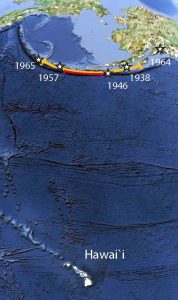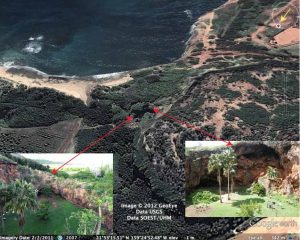13 May 2016
New research estimates probability of mega-earthquake in the Aleutians
Posted by Nanci Bompey
By Marcie Grabowski

The map showing the Aleutians with respect to Hawai’i. The red and yellow arcs indicate the sections of the Aleutian subduction zones considered in the probability analysis. Stars and dates indicate epicenters of prior 20th century great earthquakes (Mw > 8).
Credit: Butler et al., 2016.
A new study estimates the probability of a Magnitude 9+ earthquake in the Aleutian Islands—an event with sufficient power to create a mega-tsunami especially threatening to Hawai‘i. In the next 50 years, there is a 9 percent chance of such an event, according to researchers from University of Hawai‘i at Mānoa. An earlier State of Hawai‘i report has estimated the damage from such an event would be nearly $40 billion, with more than 300,000 people affected.
Earth’s crust is composed of numerous rocky plates. An earthquake occurs when two sections of crust suddenly slip past one another. The surface where they slip is called the fault, and the system of faults comprises a subduction zone. Hawai‘i is especially vulnerable to a tsunami created by an earthquake in the subduction zone of the Aleutian Islands.
Back to basics
“Necessity is the mother of invention,” said Rhett Butler, geophysicist at the UHM School of Ocean and Earth Science and Technology (SOEST) and lead author of the paper accepted for publication in the Journal of Geophysical Research: Solid Earth, a publication of the American Geophysical Union. “Having no recorded history of mega tsunamis in Hawai‘i, and given the tsunami threat to Hawai‘i, we devised a model for Magnitude 9 earthquake rates following upon the insightful work of David Burbidge and others.”
Butler and co-authors Neil Frazer (UHM SOEST) and William Templeton (now at Portland State University) created a numerical model based only upon the basics of plate tectonics: fault length and plate convergence rate, handling uncertainties in the data with Bayesian techniques.
Using the past to inform the future
To validate this model, the researchers utilized recorded histories and seismic/tsunami evidence related to the 5 largest earthquakes (greater than Magnitude 9) since 1900 (Tohoku, 2011; Sumatra-Andaman, 2004; Alaska, 1964; Chile, 1960; and Kamchatka, 1952).
“These five events represent half of the seismic energy that has been released globally since 1900,” said Butler. “The events differed in details, but all of them generated great tsunamis that caused enormous destruction.”

The only well-documented paleotsunami deposit in Hawaii from the 16th century is on Kaua`i. The Makauwahi sinkhole, on the side of a hardened sand dune, is viewed toward the southeast from an apparent altitude of 342 meters. Inset photos show two of the wall edges, indicating the edges of the sinkhole. The east wall (left) is 7.2 meters above mean sea level, and about 100 meters from the ocean. Note for scale the people in the right image.
Credit: R. Butler (left), Gerard Fryer (right), GoogleMaps (background). Figure from Butler et al., 2014.
To further refine the probability estimates, they took into account past (prior to recorded history) tsunamis—evidence of which is preserved in geological layers in coastal sediments, volcanic tephras, and archeological sites.
“We were surprised and pleased to see how well the model actually fit the paleotsunami data,” said Butler.
Mitigating the risk
Using the probability of occurrence, the researchers were able to annualize the risk. They report the chance of a Magnitude 9 earthquake in the greater Aleutians is 9 percent ± 3 percent in the next 50 years. Hence the risk is 9 precent of $40 billion, or $3.6 billion. Annualized, this risk is about $72 million per year. Considering a worst-case location for Hawai‘i limited to the Eastern Aleutian Islands, the chances are about 3.5 percent in the next 50 years, or about $30 million annualized risk. In making decisions regarding mitigation against this $30-$72 million risk, the state can now prioritize this hazard with other threats and needs.
The team is now considering ways to extend the analysis to smaller earthquakes, Magnitude 7-8, around the Pacific.
— Marcie Grabowski is an Outreach Specialist at the School of Ocean and Earth Science and Technology (SOEST) at the University of Hawaii – Manoa. The post originally appeared as a press release on the UHM website.










 GeoSpace is a blog on Earth and space science, managed by AGU’s Public Information staff. The blog features posts by AGU writers and guest contributors on all sorts of relevant science topics, but with a focus on new research and geo and space sciences-related stories that are currently in the news.
GeoSpace is a blog on Earth and space science, managed by AGU’s Public Information staff. The blog features posts by AGU writers and guest contributors on all sorts of relevant science topics, but with a focus on new research and geo and space sciences-related stories that are currently in the news.